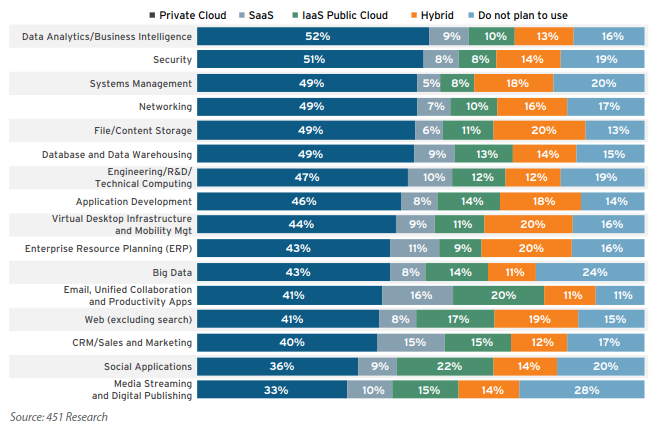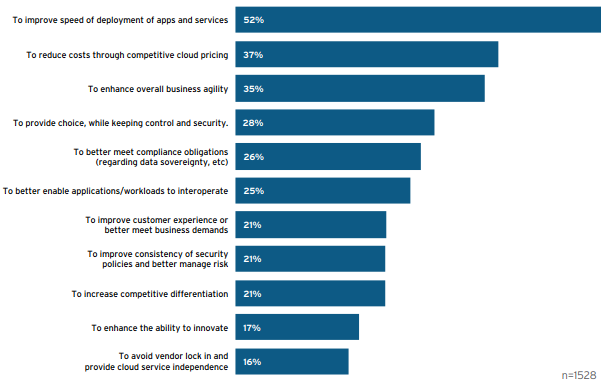
As of this year, over 80% of North American and European companies have multi-cloud infrastructures. Despite rapid cloud adoption, few companies have achieved a truly functional hybrid cloud architecture. According to a March 2018 hybrid cloud report from 451 Research and NTT Communications, around 63% of firms have a formal strategy for hybrid infrastructure. In this case, hybrid cloud does not simply mean using a public cloud and a private cloud. It means having a seamless flow of data between all clouds, on and off-premises. In this blog post, we’ll look at some of the highlights of this report, including how companies are using hybrid cloud and their perceived top challenges and benefits.
How Companies Are Using Hybrid Cloud Architecture

Some workloads are less suitable for hybrid environments. As seen in the graph above, 451 Research reports that companies are discovering file and content storage, Virtual Desktop Infrastructure (VDI) and mobility management, and Enterprise Resource Planning (ERP) are best suited for hybrid environments due to the potential to enhance performance at the edge and network functionality.
Network Computing found that three of most successful hybrid cloud use cases are disaster recovery and business continuity, archive data or data at rest, and devops application development. While cloud bursting (failing an application over to the cloud when user demand reaches a certain level) is a desirable use case for hybrid infrastructure, it has been much more challenging to implement compared to other use cases.
Top 3 Hybrid Cloud Benefits

Source: 451 Research
The top three business benefits to implementing hybrid cloud models were to improve the speed of app deployment, reduce costs through competitive cloud pricing, and to enhance business agility. By having the ability to spin up resources in the cloud with a few clicks of a mouse instead of deploying new infrastructure in the data center, companies can drastically reduce the time to market for new apps and services. With hybrid cloud management, companies have more leverage to negotiate with providers, as they can easily move their data and applications from cloud to cloud.
Top 3 Hybrid Cloud Challenges
Top challenges to implementing and maintaining a hybrid cloud architecture were managing data security, operational complexity, and inability to migrate legacy IT and business apps. Data security is more of a complex issue for European and Asian countries who are required to keep certain data stored on servers within their respective countries. Even though U.S. companies don’t have this requirement, data security across cloud platforms is still a challenge. To make security and operational complexity manageable, it’s advisable to find a cloud management platform that functions as a single pane of glass across a company’s providers, making infrastructure truly hybrid. These platforms help companies to monitor and manage security (encryption keys and role access management), analyze utilization, and manage SLAs across departments and cloud platforms.
Another challenge worth mentioning is a lack of talent. Companies are having trouble finding employees qualified to manage cloud infrastructures. Part of this has to do with the variety of options for setting up hybrid cloud architecture and rapid change. In this article, CIO says businesses with a formal cloud strategy in place reported experiencing fewer cloud failures as a result of staff (58% with no strategy vs 22% with a strategy). Having a strategy also helped with hiring – 41% of IT leaders with a cloud strategy said finding the right candidates was difficult compared to 75% of those without a strategy. For smaller companies who may think it’s a challenge to find talent before large companies, CIO suggests promoting the autonomy, diverse responsibilities, and ability to be creative they will have in a small company compared to being pigeon-holed in a specific role within an enterprise.
Looking Ahead
Surprisingly, In the next 12 months growth in IT infrastructure is not dominated by cloud. 451 Research’s survey found 24.29% of respondents will meet growing demand by expanding capacity in their existing data centers, while 23.43% said they would be meeting demand by expanding in the cloud. 10% said they would be expanding their edge computing capacity.
Further Reading
To learn more about the best cloud strategy for your business, read our blog post on finding the right cloud strategy, or learn about how we facilitate hybrid cloud architecture through CloudTap.
